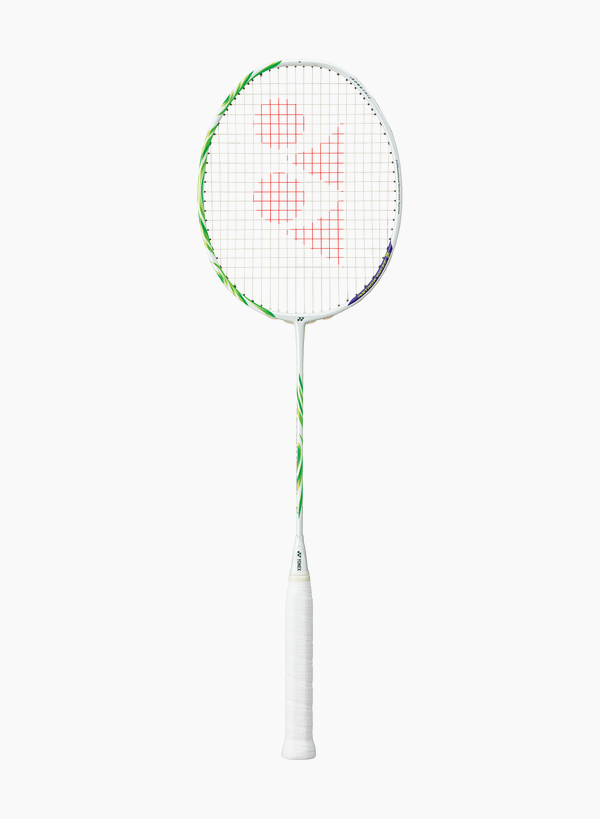Racket balance is a key specification that influences how a racket feels and behaves. Head-heavy rackets typically add power on clears and smashes, while head-light rackets improve manoeuvrability and control at the net. Here's how to choose based on your playing style.
Head-heavy
Designed for players who rely on powerful smashes and deep clears. The extra mass toward the head increases momentum and shuttle speed, but can feel less responsive for rapid exchanges at the net.
Head-light
Favoured by doubles players and those who emphasise quick drives and net play. The lighter head allows faster wrist action and quicker recovery between shots, improving reaction speed.
Balanced / Mid-balance
Offers an all-round feel suitable for club players who play both singles and doubles. A good compromise between power and control.
How to choose
- Try demo frames at any of the shops — feel is subjective and crucial.
- Consider string tension alongside balance: tighter strings favour control.
- Small weight adjustments (grip tape, lead tape) can fine-tune balance to your preference.
Speak to our coach Nelson if you're unsure — testing different balances in practice is the best way to find a match for your style.
Racket Examples by Balance

Head-heavy — Yonex Astrox (example)
Designed for aggressive attackers seeking extra shuttle speed on smashes and clears. Expect more momentum through the head.
Typical players: Singles attackers, players wanting extra power.

Balanced / Mid-balance — Yonex Arcsaber (example)
A versatile frame that offers a compromise between power and control — suitable for club players who mix singles and doubles.
Typical players: All-rounders and recreational players.

Head-light — Yonex Nanoflare (example)
Built for speed and manoeuvrability — great for quick drives, fast exchanges and net play.
Typical players: Doubles players, those emphasising quick wrist action.
Note: model names shown are examples — check manufacturer specs and demo rackets to confirm balance and feel.
Strings & Tension
Strings and tension are as important as the frame. Lower tensions (18–22 lbs) give a larger sweet spot and more power for most club players. Higher tensions (23–30+ lbs) provide better control and feel but require technically consistent striking.
- Power-oriented: use a softer multifilament or lower tension to increase repulsion.
- Control-oriented: use a thinner monofilament (e.g. 0.66–0.69mm) at higher tension for sharper feel.
- Durability: use thicker gauges (0.70–0.72mm) if you break strings often.
Weight Classes & Feel
Rackets are commonly described by weight categories (e.g. 2U ≈ 90–94g, 3U ≈ 85–89g, 4U ≈ 80–84g). Heavier rackets often deliver more power but require more effort; lighter rackets are quicker to swing.
- 2U / 3U: more mass, often paired with head-heavy balance for attacking players.
- 4U / 5U: lighter, easier to maneuver—favoured in doubles and fast exchanges.
Grip Sizes & Comfort
Choose a grip size that lets you hold the racket comfortably without excessive squeezing. Add or remove overgrip layers to fine-tune thickness. Smaller grips favour wrist work; larger grips can aid stability for heavier swings.
Adjusting Balance (Lead Tape)
Use small pieces of lead tape to shift the balance point: adding tape to the head makes the racket head-heavier.
Beginner / Recreational
3U–4U frame, mid-balance, multifilament string at 18–22 lbs — forgiving and easier for learning technique.
Intermediate / Club
3U frame, slightly head-heavy for extra power, poly/synthetic hybrid string at 22–25 lbs — balance of power and control.
Advanced / Doubles Specialist
4U / 5U head-light frame, thin polyester string at 24–28+ lbs — maximum manoeuvrability and fast drives.
Maintenance & Care
- Keep rackets in a temperature-stable environment; extreme heat can warp frames.
- Replace strings proactively if you notice fraying — maintain tension suited to your play.
- Use a quality overgrip and replace when it becomes slippery to maintain a secure hold.
- Inspect for cracks after hard impacts; a damaged frame will affect balance and safety.
Choosing for Your Game
Match racket characteristics to how you play — power, control, or speed. Consider the following quick guide:
- Power-focused: heavier head or slightly head-heavy, 2U/3U frame, moderate tension (20–24 lbs).
- Control-focused: balanced or head-light, higher string tension (23–28 lbs), thinner gauge string.
- Speed/manoeuvrability: light head-light frames (4U/5U), lower swing weight, faster wrist movement.
How to Test a Demo Racket
- Warm up with the demo for at least 10–15 minutes — try clears, drives, net shots and smashes.
- Pay attention to recovery speed after shots and how your wrist reacts during flicks and drives.
- Test different tensions on the same frame if possible — tension changes the feel dramatically.
- Notice comfort: grip size, vibration, and any discomfort in the wrist or elbow.
Quick Checklist
Use this when demoing rackets:
- Comfortable grip and no excessive shock.
- Acceptable balance for your preferred shots.
- Strings and tension suit your control vs power needs.
- Manageable weight over a 30–60 minute session.
Pros & Cons Summary
Head-heavy
- Pros: extra power, strong smashes.
- Cons: slower at net, more demanding physically.
Balanced
- Pros: versatile, suitable for mixed play.
- Cons: not specialized — may lack extreme power or speed.
Head-light
- Pros: fast, agile, excellent for doubles.
- Cons: less raw power on clears/smashes.